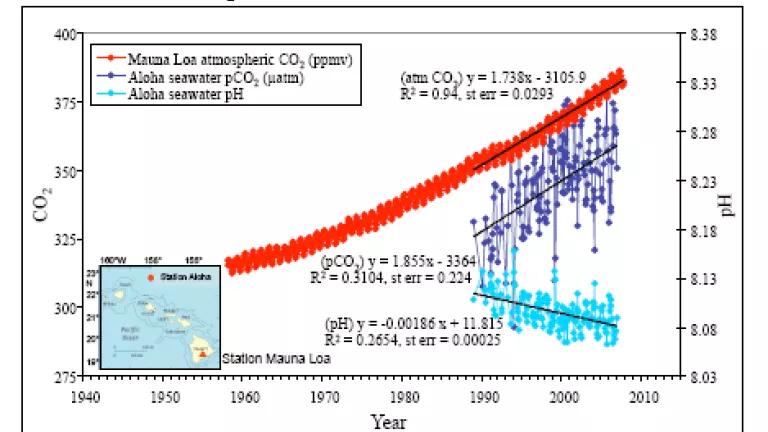
A past comment on this blog raised an excellent question. Captain Crutcher writes:
"How can we be sure that this cycle we are observing with our highly tuned skills is caused solely by humans ... has this happened before, prior to our human ability [to] influence marine ecosystems?"
So, how do scientists know that the observed decrease in average ocean pH - or rising acidity - over the past two hundred years is the direct result of human activities?
The short answer is because theory (i.e., the laws of physics and chemical thermodynamics) predicts it, and observations confirm it.
There are three well established processes in the phenomenon of ocean acidification:
- Atmospheric CO2 concentrations are rising, primarily from the combustion of fossil fuels (see 'Keeling curve' below).
- The ocean absorbs a large amount of this CO2. It has to. There's no known mechanism that would prevent this.
- When CO2 gas dissolves into water, it becomes an acid.
CO2 + H2O ↔ H2CO3 ↔ H+ + HCO3-. (H2CO3 is carbonic acid which immediately dissociates and releases a hydrogen ion, H+, which is the 'acid').
It is important to note that these processes are not complex; they are known to be true and are observable and measurable.
The theoretical underpinnings of chemistry allow scientists to predict the expected change in pH (or 'rise in acidity') in surface waters, given the influx of a known amount CO2 into the ocean. These predictions are verified by what we measure happening in the ocean.
The figure below, showing field measurements of CO2 in the air and the ocean at Hawaii, illustrates this point well. The red diamonds show rising atmospheric CO2 concentrations as a result - primarily - of fossil fuel combustion (this is the famous 'Keeling curve'). The dark blue diamonds show the concomitant rise in CO2 in the ocean. Although more variable (due to local variations in weather, temperature, biology, and mixing) the rise in oceanic CO2, clearly tracks the rise in atmospheric CO2. Finally, the light blue diamonds show ocean pH declining by the expected amount given the measured influx of CO2. Other long-term pH sampling stations around the world (e.g., Bermuda and the Canaries) tell similar stories.
Time series of: (a) atmospheric CO2 at Mauna Loa (in parts per million volume, ppmv) (red ), surface ocean pH (cyan), and pCO2 (μatm) (tan) at Ocean Station ALOHA in the subtropical North Pacific Ocean (From Doney et al., Annual Review of Marine Science, 2009 1: 169-92)
In other words, we see a declining trend in ocean pH, and we can attribute that trend quantitatively to the rise in atmospheric CO2 due to fossil fuels. The concurrence between theory and observation - as well as the absence of good alternative explanations - gives scientists high confidence that carbon dioxide pollution is causing ocean acidification.
It's really not much different from predicting that a cup of vinegar added to a gallon of distilled water will drive the acidity of that water up by a given amount - adding the vinegar - and then observing that the acidity did, indeed, go up by the expected amount. The logical, and most parsimonious, explanation is that the added vinegar caused the rise in acidity. To conclude otherwise would require an explanation for 1) what unknown process(es) neutralized the added acidity of the vinegar and 2) what alternative, unseen constituent(s), alternatively, caused the observed rise in acidity.
To return to the question, "Is nature causing the recent observed decline in global ocean pH?" - The answer is, extremely unlikely. Currently, there are no known natural explanations for the observed decline in GLOBAL AVERAGE ocean pH, and, there is one, clear human-caused explanation (note the global bit is important - there is natural local variation in pH but we are concerned with global shifts).
Captain, if your ship were to suddenly take on water and you could identify a clear leak in the hull (one the size that would explain the amount of incoming water) - wouldn't it be negligent to ignore that leak in favor of finding an unseen one?
On Natural Variation of Global Surface Ocean pH -
Direct historical measures of ocean pH (on the scale of millions of years) do not exist. However, scientists have used proxies (e.g., boron isotopes from ancient plankton shells) to formulate reasonable estimates of historic ocean pH.
Pearson and Palmer (2000 Nature) use this technique, and show that global average surface ocean pH has varied over time (though not necessarily cyclically), but that it has been relatively stable over the past 24 million years, ranging from 8.3-8.1. Most importantly, changes in average surface pH appear to be gradual, on the scale of tens of thousands to millions of years. What concerns scientists most about the recent observed, and predicted, changes in ocean pH is that it is extremely - unprecedentedly - rapid (check out Stanford's tutorial of ocean acidification - slide 4 - for a nice visual of this). Scientists predict a change in average surface ocean pH from 8.10 to as low as 7.8 in 100 years, if we continue to pollute as we are now. It is this rapid rate of change that is most threatening to biology because evolution might not be able to keep up with the environmental change.
There have been a few dramatic ocean acidification events in Earth's distant history. These were caused by massive, natural input of carbon dioxide into the ocean (for example from volcanoes). The best studied example is the Paleocene-Eocene Thermal Maximum (PETM) 55 million years ago. As expected, this event was associated with extinction of numerous calcifying organisms. However, because the world was a very different place back then (for example tropical coral reefs did not exist) and because ocean pH was not the only environmental factor that changed (temperature and oxygen availability changed as well), it is not clear what lessons can be learned from these past events.
